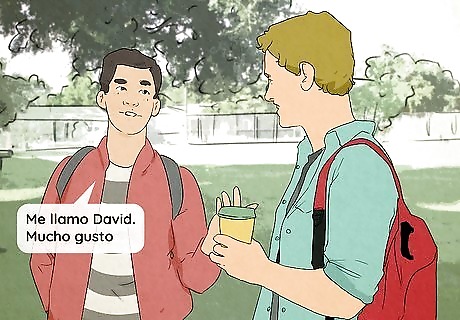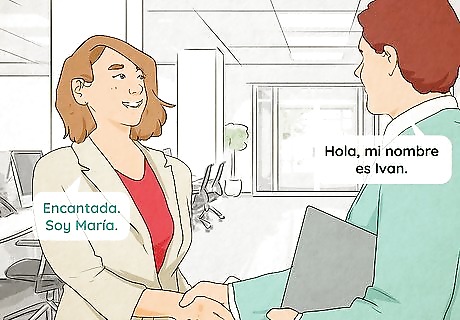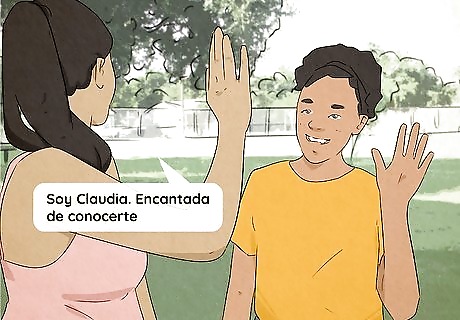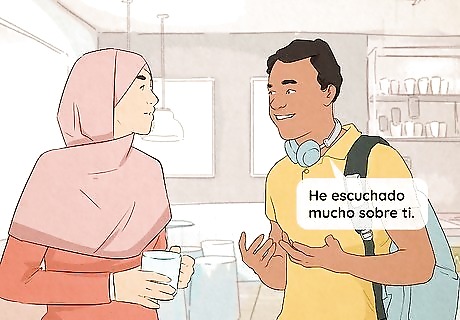
views
“Mucho gusto.” (MOO-cho GOO-sto)

This is the standard way of saying “nice to meet you” in Spanish. It’s an extremely useful phrase to have in your Spanish vocabulary, and you’ll likely hear it quite often if you’re hanging out with Spanish speakers. “Me llamo David. Mucho gusto.” (“My name’s David. Nice to meet you.”). Them: “Te quiero presentar a mi novia, Susan.” (“I’d like to introduce you to my girlfriend, Susan.”) You: “Mucho gusto.” (“Nice to meet you.”).
“Mucho gusto en conocerte.” (MOO-cho GOO-sto en con-O-ser-tay)

Use this longer phrase to flex your Spanish muscles. Although “mucho gusto” is completely appropriate on its own, for a slightly more elevated response, try saying “mucho gusto en conocerte,” which could be translated to “It’s very good to meet you.” If you’re speaking with someone who is older than you or want to show extra respect, try saying “mucho gusto en conocerle.” (MOO-cho GOO-sto en con-O-ser-lay). “Soy tu vecino. Mucho gusto en conocerte.” (“I’m your neighbor. It’s very good to meet you.”) “Usted debe ser el gobernador. Mucho gusto en conocerle.” (“You must be the governor. It’s very good to meet you.”).
“Encantado.” (en-cahn-TA-do)

“Encantado” is an alternative for “mucho gusto,” especially in Spain. It literally means “delighted,” but is also one of the main ways of saying “nice to meet you.” Although speakers of Latin American Spanish will understand “encantado” as well, and may even use it themselves, it’s most popular in European Spanish. Spanish uses grammatical gender, meaning “encantado” changes form depending on the gender of the speaker. If you’re a woman, say “encantada” (en-cahn-TA-da) instead. “¡Finalmente nos conocemos en persona! Encantado.” (“We finally meet in person! Nice to meet you.”) Them: “Hola, mi nombre es Ivan.” (“Hello, my name is Ivan.”) You: “Encantada. Soy María.” (“Nice to meet you. I’m Maria.”).
“Encantado de conocerte.” (en-cahn-TA-do day con-O-ser-tay)

Use this phrase to make “encantado” sound more elevated. The English translation of this expression is “pleased to meet you.” Try it when you want to sound a bit sophisticated or formal. Don’t forget to change the form of “encantado” depending on the gender of the speaker. If you’re a woman, say “encantada de conocerte” (en-cahn-TA-da day con-O-ser-tay) instead. When speaking with someone who is older than you or in a position of authority, try saying “encantado/a de conocerle” (en-cahn-TA-do/da day con-O-ser-lay). “Soy Claudia. Encantada de conocerte.” (“I’m Claudia. It’s a pleasure to meet you.”). “Buenos días Señora Medina. Encantado de conocerle.” (“Good morning, Mrs. Medina. It’s a pleasure to meet you.”).
“Es un placer.” (ess oon PLA-ser)

This Spanish phrase translates to “it’s a pleasure.” You can use “it’s a pleasure” as a handy alternative for “nice to meet you” in Spanish, just as you would in English. This response may be a bit more formal than “mucho gusto,” but it’s useful in many different situations. “Siempre es un placer, Señor Bolaño.” (“It’s always a pleasure, Mr. Bolaño.”) Them: “Este es mi amigo, Jacobo.” (“This is my friend, Jacobo.”) You: “Es un placer, Jacobo.” (“It’s a pleasure, Jacobo.”).
“Fue un placer.” (foo-AY oon PLA-ser)

Try using this phrase (“It was a pleasure”) at the end of a conversation. “Fue” is a past-tense form of “es,” and is therefore useful when you want to let someone know that it was good to meet them. “Tengo que irme. Buenas noches, señora, fue un placer.” (“I have to go. Good night, ma’am, it was a pleasure to meet you.”) “Me lo pasé muy bien esta noche. Fue un placer.” (“I had a great time tonight. It was a pleasure.”)
“He escuchado mucho sobre ti.” (eh ess-koo-CHA-do MOO-cho SO-bray tee)

This phrase translates to, “I’ve heard so much about you.” Like in English, you can use it as another way of expressing the same idea as “nice to meet you” if this is someone whom you were familiar with before meeting for the first time. “¡Eres Sabina! He escuchado mucho sobre ti.” (“You’re Sabina! I’ve heard so much about you.”) “¡El famoso Rafael! He escuchado mucho sobre ti.” (“The famous Rafael! I’ve heard a lot about you.”) Margarita Madrigal Margarita Madrigal, Spanish Language Expert The most common Spanish phrase for 'nice to meet you' is 'mucho gusto.' You'll want to practice saying 'mucho gusto' with the correct pronunciation to properly introduce yourself in Spanish-speaking situations. When said fluidly, with the emphasis on the middle syllable 'gus,' it will roll smoothly off your tongue and leave a positive first impression.


















Comments
0 comment